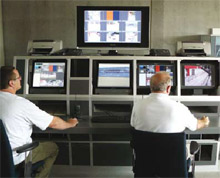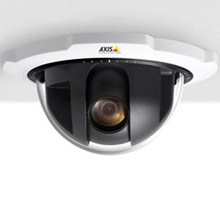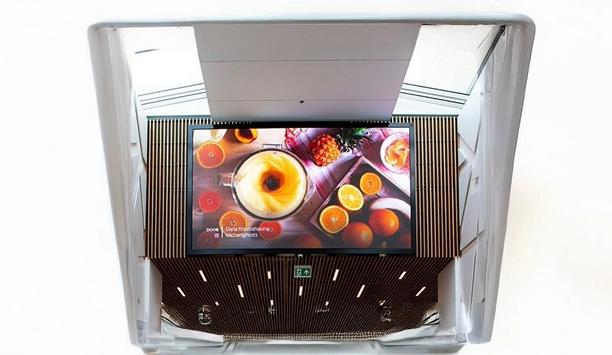Mission
The Mons/Bergen football club is a dependable name in the world of Belgian football. In 2000, while it was playing in the second division, security for the Mons/Bergen Stadium, consisted of four analogue cameras. When the club entered the premier division in 2002, it had to bring its stadium into line with the new security legislation. Aware of the limitations of the old analogue system, officials sought to implement an alternative solution to ensure better image quality and easy access to video by authorized personnel.
Solution
In an effort to reduce costs, it was decided to install a network video system using Axis network cameras and including, via Axis video servers, a series of analogue cameras that could still provide satisfactory performance.
In addition to requirements in terms of image quality, ease of use was also an important factor in selecting a new security solution. After comparing various systems, the decision was made to select Axis network cameras, and to engage Digital, an Axis partner in Belgium, to install the entire new video surveillance system.
Result
Surveillance of the stadium is now under control and in line with Belgian legal requirements. All interior and exterior areas, including the immediate surroundings and the parking lot, are under video monitoring, to the great satisfaction of both the operators and the local police.
"We are extremely satisfied with the features provided by this new remote video surveillance system. We have been particularly surprised by the very short implementation time, high image quality and ease of use of Axis network cameras," says Michel Taulet, Infrastructure and Security Supervisor of Mons/Bergen Stadium.
Strict security measures
After a series of serious incidents, the Belgian government decided to impose a number of standards on football clubs playing in the premier and second divisions, to improve the safety of the clubs' employees, as well as visitors and players. "Security in and around our stadium, which will soon have a capacity of 13,000 visitors, has always been a topic of major importance for us. When our football club entered the premier division, we did all the necessary changes to quickly meet the legal requirements," said Mr Taulet, Infrastructure and Security Supervisor of Mons/Bergen Stadium.
A series of strict rules was implemented: mandatory training for users, maintenance contract, installation of a panel to report on the current state of the cameras, and any malfunctions that arise have to be dealt with consistently after each match and prior to the start of the next match. A total of four operators, two of whom are stadium employees, and two from the Mons/Bergen Police, are trained and authorized to use the cameras in the Mons/Bergen Stadium.
Mr Taulet explains: "When violence or vandalism occurs, we have to provide conclusive evidence to the courts. This means images that can actually show the guilt or innocence of a supporter. This is where there was a problem: the quality of the images from the analogue cameras we were using was not sufficient to correctly identify individuals."
Another hindrance was that the operator did not have an overview of the situation on the football ground and around it. That was due to the fact that there was only access to a limited number of viewing angles coming from one analogue camera at a time. "Quite often, we were not able to detect undesirable behaviour until after the match, when the recorded images were analyzed. And to make matters worse, the analogue cameras were difficult to use."
From analogue to network video
Surveillance of the stadium is now provided by nine cameras; four of which are analogue and five digital. Three AXIS 214 PTZ network cameras provide video surveillance of the parking lot, street and access points to the stadium through remote monitoring functions. Surveillance of the stands is provided by two motorized AXIS 232D+ network dome cameras and four analogue cameras, and the bar is under the watchful eye of an AXIS 225FD fixed dome network camera.
In the control room, a large screen offers an overview of what is happening inside the stadium and its immediate surroundings. Four smaller screens provide the possibility of zooming into specific shots. The network cameras are controlled by two operators in radio contact with the Mons/Bergen Police, which facilitates speedy intervention. "The Axis network cameras completely meet the security requirements imposed on us by Belgian legislation," Mr Taulet concludes.
Future expansion
A new stand, which was built in August 2007, will be equipped with two AXIS 233D network dome cameras. Video surveillance of the bar next to the new stand will be provided by an AXIS 225D fixed dome network camera.












